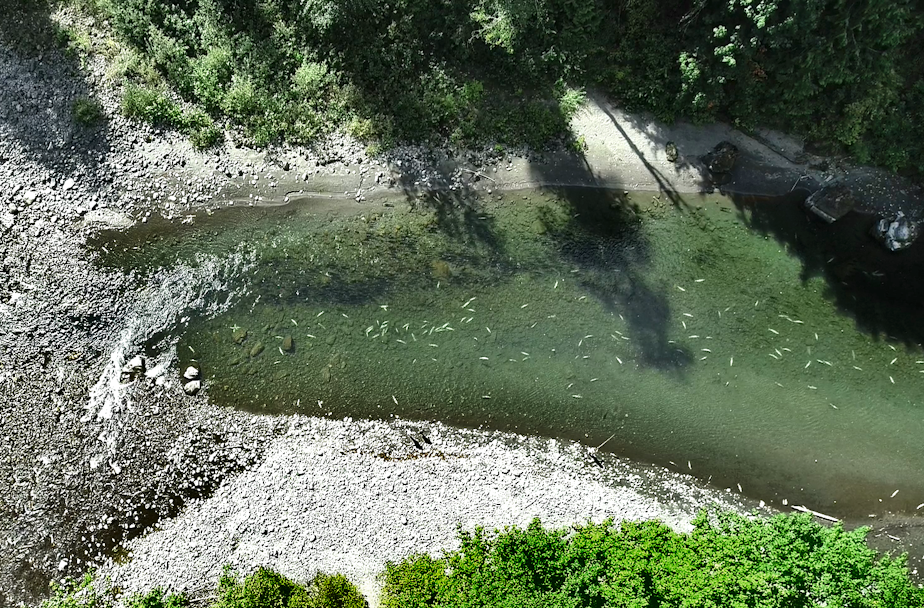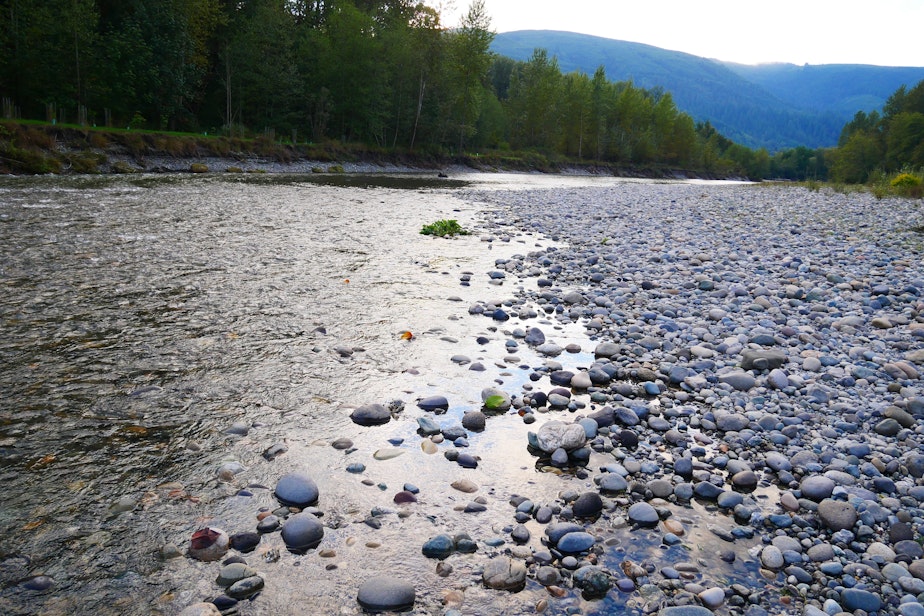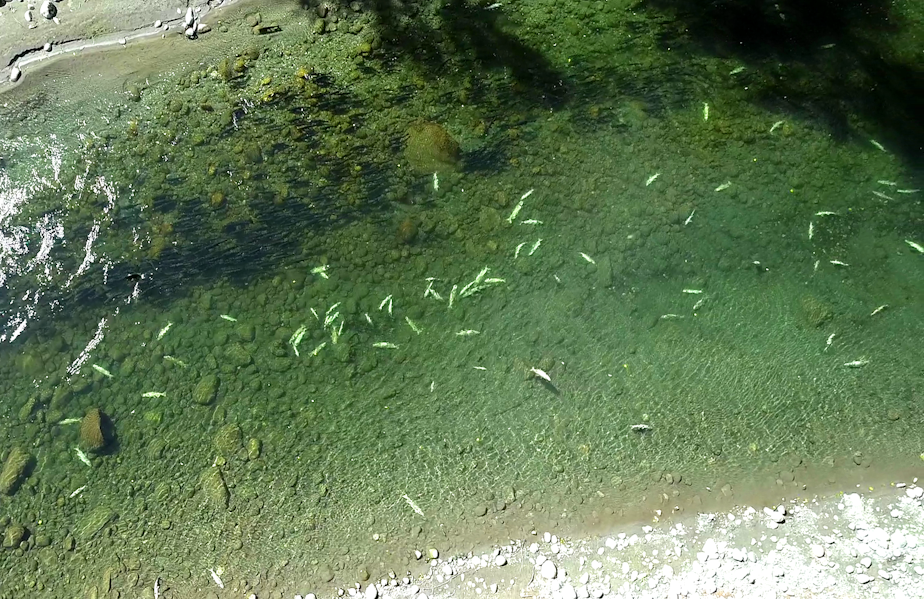Heat-loving bacteria kill thousands of Washington salmon

An estimated 2,500 Chinook salmon died before they could reach their spawning grounds in Whatcom County in September.
Lummi Nation officials say a triple whammy of warm water, low flows, and bacteria killed 80% or more of Chinooks returning to the South Fork Nooksack River.
Drone photos show their bleached-white carcasses – the latest victims of the Northwest’s summer of deadly heat – littering the bottom of the river.
Tribes and state officials have been working for years to bring the South Fork Chinook population back from the brink of extinction.
Councilmember Lisa Wilson of the Lummi Indian Business Council, the governing body of the Lummi Nation, said her stomach dropped when she heard about September’s dieoff.
“We've been working so hard in so many areas to get fish back for our people,” Wilson said. “So that is devastating to me when we are finally getting things moving in the right direction.”
“To the Lummi Nation, salmon is as important as the air that we breathe,” she said.
Puget Sound Chinook salmon have been federally listed as a threatened species since 1999. They’ve come closer to going extinct in the South Fork than any other river.
In 2013, just 10 Chinooks – the largest of the Pacific salmon and the main food of the Northwest's endangered orcas – returned to the river.
Efforts to restore the South Fork Chinooks' habitat and breed them in a hatchery on the South Fork have helped their numbers bounce back, with 1,300 adults returning to spawn by 2018.
“We see columnaris virtually every year,” Lummi Natural Resources Department biologist Tom Chance said of the disease behind the dieoff. “Of course, in previous years, it's been nowhere close to this scale.”
Veterinarians say Flavobacterium columnare, the bacteria that causes columnaris disease, is always present in Northwest waters. It does little harm unless the water gets too warm, as it did with this summer’s heat waves and drought.
“We are seeing more and more columnaris disease and [the parasite known as] Ich everywhere due to climate change,” Northwest Indian Fisheries Commission veterinarian Nora Hickey said in an email. “It just happens that this year these emerging problems were more apparent in the South Fork Nooksack.”
Chance said the usually rare parasite Ich (short for Ichthyophthirius multifiliis) was found on all the fish that veterinarians sampled from the river.
“We've also noticed here where we live, in the river, more dead salmon during the summer as well, just floating,” said Abby Yates, who lives just downstream on the mainstem Nooksack River near Everson, Washington.
“Salmon have always been a way of life for my family, but also for our tribe,” the Nooksack tribal member said. “My dad made the best smoked salmon ever. It's just a constant while I was growing up and still to this day.”
Of course, seeing dead salmon in a river can be a good thing: The carcasses of spawned-out salmon enrich inland ecosystems by delivering nutrients from the sea.
Scientists are concerned about what they call “pre-spawn mortalities”—fish that die before spawning or even reaching their spawning grounds.
“In the last couple of years, it's been a lot of them,” Yates said.

Chance said most of the Chinook that died in September had returned from the ocean to freshwater in June or July, then took several weeks to muscle their way up the Nooksack River from Bellingham Bay and into the South Fork.
U.S. Geological Survey river gauges show temperatures in the South Fork peaking in August at 72 degrees – far above what scientists consider the lethal limit for salmon.
Extreme heat puts stress on all sorts of organisms, from trees to humans. According to the Washington Department of Health, heat killed 138 people in Washington state this summer.
“When you and I are out in hot weather and we get exhausted, the fish have the same problem metabolically,” said veterinary pathologist Kevin Snekvik with the Washington Animal Disease Diagnostic Laboratory at Washington State University.
The fish-killing bacteria proliferate in late summer or fall, when water temperatures peak and water flows hit their annual lows.
“The fish become stressed, and then once the fish is stressed, then that kind of allows for this bacteria to cause problems,” he said. “The salmon immune system is built to function in colder water, which is why they're native to the Pacific Northwest.”
Biologist Tom Chance says habitat degradation is still the main driver of the decline of Puget Sound Chinooks. But “climate change exacerbates existing problems that we have in virtually every single Puget Sound basin,” he said.
The two tribes of the Nooksack basin are working to keep their shared river cool. Priority work includes habitat projects to make sure the river has deep pools of cool water – “temperature refuges,” they’re called – and a legal fight to leave more water in the river each summer, for higher, cooler flows.
The Whatcom County Family Farmers association opposes the tribes’ efforts to sort out and enforce the Nooksack Valley’s water rights: They expect they could lose access to the water they use to irrigate crops.
The tribes’ water rights date back to the 1855 Treaty of Point Elliott and outrank those of farmers.
The farmers association says it favors a more collaborative approach to water management.





